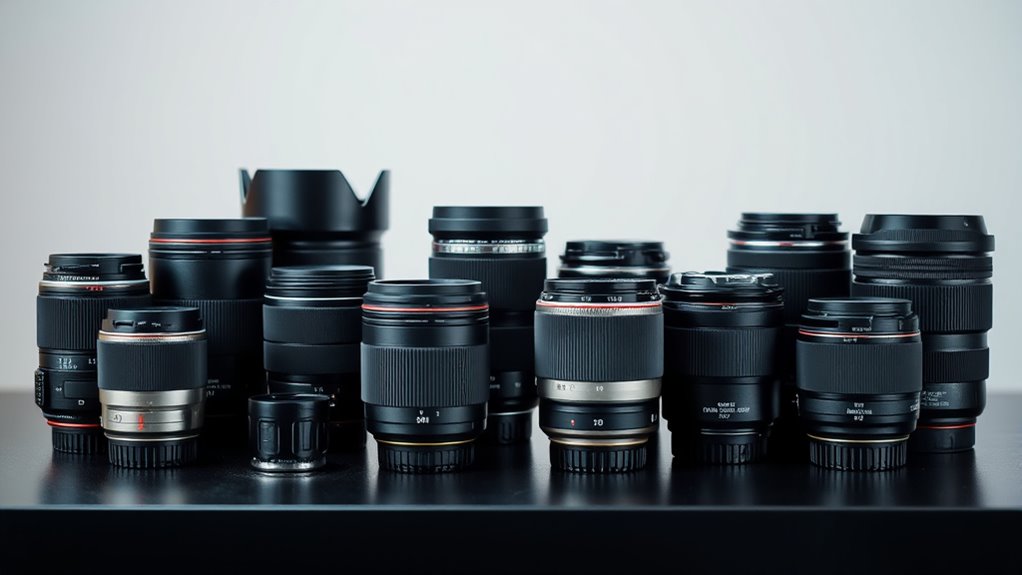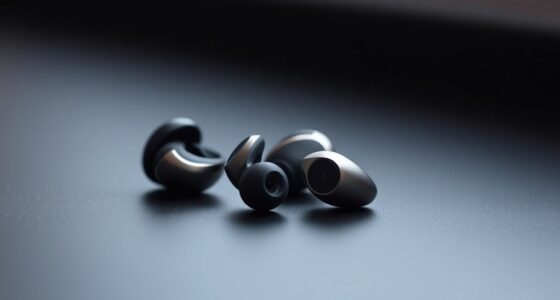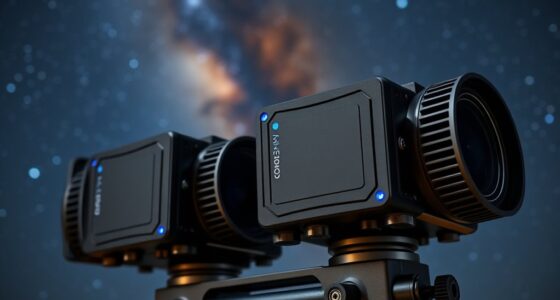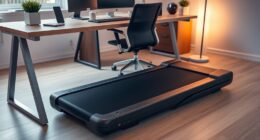If you’re searching for the 14 best premium DSLR lenses that deliver stunning photos, I’ve got you covered. I’ve seen top options for portraits, wildlife, telephoto, and versatile zooms, all designed for professional results. From prime lenses like the Canon 50mm f/1.8 to high-power telephoto zooms like the Nikon 200-500mm, each offers exceptional image quality and build. Keep exploring, and you’ll discover which lenses fit your photography style perfectly.
Key Takeaways
- The list includes top-tier prime and zoom lenses optimized for various photography styles like portraits, wildlife, and astrophotography.
- Each lens offers high-quality optics, wide apertures, and advanced coatings for sharp, vibrant, and low-light images.
- Compatibility spans major DSLR brands such as Canon, Nikon, and others, ensuring versatile usage across different camera systems.
- Features like fast autofocus, manual focus options, and stabilization enhance image precision and creative control.
- The selection balances durability, build quality, and optical performance to deliver stunning professional-grade photos.
Canon EF 50mm f/1.8 STM Lens
If you’re looking for an affordable yet versatile lens that delivers professional-quality images, the Canon EF 50mm f/1.8 STM is an excellent choice. Its bright f/1.8 aperture excels in low-light situations, producing sharp photos with beautiful background blur (bokeh). Compact and lightweight at just 5.6 ounces, it’s perfect for everyday photography, from portraits to street scenes. The STM autofocus system is quiet and smooth, ideal for capturing moments or shooting videos. Compatible with many Canon EOS models, it supports full-time manual focus and offers great image clarity, making it a top-value lens for beginners and enthusiasts alike.
Best For: photographers and videographers seeking an affordable, versatile lens ideal for portraits, low-light shooting, and cinematic video work.
Pros:
- Excellent low-light performance with a bright f/1.8 aperture producing sharp images and beautiful background blur
- Compact, lightweight design (5.6 oz), perfect for daily carry and extended shooting sessions
- Near-silent, smooth autofocus thanks to STM technology, ideal for both photography and videography
Cons:
- Fixed 50mm focal length may limit versatility for wide-angle or macro shots
- Some older Canon cameras might not support the full silent autofocus feature
- No image stabilization, which can affect handheld shooting in certain conditions
Canon EF 75-300mm f/4-5.6 III Telephoto Zoom Lens for Canon SLR Cameras
The Canon EF 75-300mm f/4-5.6 III Telephoto Zoom Lens is an excellent choice for beginner photographers or hobbyists seeking an affordable, versatile telephoto lens. It offers a focal range ideal for portraits, wildlife, and nature shots, with 13 elements in 9 groups. While autofocus is slower and noisier due to the DC motor, manual focus provides flexibility. The lens is sturdy and suitable for outdoor use, though it’s relatively heavy. Sharp images are achievable at 75-200mm, but quality diminishes at 300mm. Overall, it’s a great budget option for capturing distant subjects, especially when used with a tripod or fast shutter speeds.
Best For: beginner photographers, hobbyists, and outdoor enthusiasts seeking an affordable telephoto lens for portraits, wildlife, and nature photography.
Pros:
- Affordable price point with good build quality
- Versatile focal length suitable for various outdoor subjects
- Compatible with additional accessories like close-up lenses
Cons:
- Slower and noisier autofocus due to DC motor
- Reduced sharpness at 300mm and maximum zoom
- Heavier weight compared to standard kit lenses
Nikon AF-S FX NIKKOR 50mm f/1.8G Lens for Nikon DSLR Cameras
For photographers seeking a versatile prime lens that delivers sharp images across the frame, the Nikon AF-S FX NIKKOR 50mm f/1.8G stands out as an excellent choice. Designed for Nikon DSLR cameras, it features a bright f/1.8 aperture that excels in low light and creates beautiful background blur. Its optical system includes an aspherical element for edge-to-edge sharpness on FX and DX formats. The silent wave motor ensures fast, quiet autofocus, while the compact size makes it easy to carry. With a minimum focus distance of 1.48 feet and a 58mm filter thread, it’s perfect for portraits, street, and everyday photography.
Best For: photographers seeking a versatile, sharp prime lens for portraits, street, and everyday photography on Nikon DSLR cameras.
Pros:
- Bright f/1.8 aperture ideal for low-light conditions and beautiful background blur
- Edge-to-edge sharpness thanks to the aspherical lens element for both FX and DX formats
- Compact and lightweight design makes it highly portable and easy to carry
Cons:
- Fixed 50mm focal length limits zoom versatility
- Minimum focus distance of 1.48 feet may be restrictive for close-up shots
- No built-in image stabilization, which could affect handheld shooting in low light
EF 85mm f1.8 Portrait Lens for Canon DSLR Cameras
Are you a professional or serious enthusiast aiming for stunning portrait shots with exceptional background blur? The EF 85mm f1.8 Portrait Lens for Canon DSLR cameras is an excellent choice. It’s compatible with a wide range of Canon EOS models, offering precise manual focus for creative control. The lens features a fast f1.8 aperture, producing beautiful bokeh and sharp images. Its hybrid aspherical elements and UMC coating reduce aberrations and glare, ensuring clarity and contrast. The smooth focus ring allows for accurate adjustments, making it ideal for portraiture. Plus, Canon’s reliable after-sales support gives you peace of mind. This lens truly elevates your portrait photography.
Best For: professional photographers and serious enthusiasts seeking high-quality portrait shots with beautiful background blur and precise manual focus control.
Pros:
- Exceptional image sharpness and beautiful bokeh with f1.8 aperture
- Reduced aberrations and glare thanks to hybrid aspherical elements and UMC coating
- Precise manual focus with smooth focus ring for creative control
Cons:
- Fully manual focus may require some adjustment for users accustomed to autofocus
- No electronic contacts, limiting automatic aperture control and metadata transfer
- Compatibility limited to Canon DSLR cameras, not suitable for mirrorless or other systems
High-Power 500mm/1000mm f/8 Manual Telephoto Lens for Nikon Cameras
If you’re serious about capturing distant subjects with incredible clarity, the High-Power 500mm/1000mm f/8 Manual Telephoto Lens for Nikon Cameras stands out as an excellent choice. Designed for Nikon DSLR cameras with F-Mount compatibility, it offers superb optical quality thanks to high index, low dispersion multi-coated glass. The lens includes a 2X Teleconverter, doubling its magnification to 1000mm, perfect for wildlife, landscapes, or celestial photography. Manual focus and aperture control give you full creative precision, while its rugged build withstands outdoor conditions. This lens combines power, versatility, and durability, making it ideal for enthusiasts and professionals seeking detailed, distant shots.
Best For: outdoor photographers, wildlife enthusiasts, and celestial observers seeking high-quality, long-distance imaging with manual control and durable construction.
Pros:
- Exceptional optical clarity with high index, low dispersion multi-coated glass for sharp, detailed images
- Powerful 1000mm magnification with included 2X Teleconverter, ideal for distant subjects
- Rugged, weather-resistant build suitable for outdoor photography in various conditions
Cons:
- Manual focus and aperture may be challenging for beginners or fast-paced shooting situations
- Fixed f/8 aperture limits performance in low-light environments
- Heavy and bulky design can be difficult to carry and handle for extended periods
Nikon 55-300mm f/4.5-5.6G ED Vibration Reduction Zoom Lens for Nikon DSLR
The Nikon 55-300mm f/4.5-5.6G ED Vibration Reduction Zoom Lens is an excellent choice for photographers seeking versatile telephoto zoom capabilities without breaking the bank. Its 5.5x magnification and 82.5-450mm equivalent view make it perfect for wildlife, sports, and travel shots. The lens’s ED elements and Nikon’s Super Integrated Coating reduce chromatic aberration and flare, delivering sharp, vibrant images. With Nikon’s Silent Wave Motor, autofocus is quick and quiet. VR II stabilization allows handheld shooting at shutter speeds up to four stops slower, ensuring sharpness even in challenging lighting conditions. Overall, it offers great value and solid performance for enthusiast shooters.
Best For: photographers seeking an affordable, versatile telephoto zoom lens for wildlife, sports, travel, and general outdoor photography.
Pros:
- Excellent zoom range (55-300mm) suitable for capturing distant subjects like wildlife and sports
- Effective image stabilization (VR II) for sharp handheld shots even in low light
- Compact, lightweight design with high-quality optics and quiet autofocus
Cons:
- Possible internal dust, smudges, or spots due to refurbished status that may affect image quality
- Autofocus can be slow and hunt in low-light conditions
- Some users find it heavier than expected for a compact telephoto lens
EF/EF-S 420-800mm F8.3 Telephoto Zoom Lens for Canon DSLR
Photographers who enjoy long-distance shots will find the EF/EF-S 420-800mm F8.3 Telephoto Zoom Lens an excellent choice, especially for wildlife, birding, and astrophotography. This fully manual focus lens fits Canon EOS DSLRs, offering a versatile 420-800mm zoom range with a fixed aperture from f/8.3 to f/16. It’s lightweight and portable but requires a tripod for stability. While it lacks electronic contacts and manual aperture control, its sharp images and background bokeh make it valuable for experienced photographers willing to adapt to manual operation. Despite some connector issues, its affordability and long-distance capabilities make it a compelling, budget-friendly telephoto option.
Best For: photographers experienced with manual focus seeking an affordable, long-distance telephoto lens for wildlife, birding, and astrophotography on Canon DSLR cameras.
Pros:
- Cost-effective option with a long zoom range of 420-800mm suitable for distant subjects.
- Produces sharp images with pleasing background bokeh thanks to internal focus and UMC technology.
- Lightweight and portable design, making it easy to carry and set up with a tripod.
Cons:
- Fully manual focus and lack of electronic contacts require practice and camera adjustments.
- Fixed aperture limits exposure control and may pose challenges in varying lighting conditions.
- Connector ring fit issues and the need for modifications can complicate setup and use.
Altura Photo Camera Cleaning Kit (DSLR & Electronics)
For anyone serious about maintaining their DSLR gear, the Altura Photo Camera Cleaning Kit offers an essential set of tools that guarantee your equipment stays spotless and performs at its best. It includes a 2oz spray lens cleaner, lens cleaning pen, brush, air blower, microfiber cloths, and cleaning tissues—compatible with all camera brands and models. The alcohol- and ammonia-free spray evaporates quickly, ensuring no moisture damage. Users report sharper images and cleaner lenses after use. Compact and lightweight, this kit fits easily into your bag for on-the-go cleaning. It’s a reliable, affordable solution that helps protect your gear and extend its lifespan.
Best For: photographers, videographers, and electronics users seeking a reliable, portable cleaning solution for DSLR cameras and sensitive devices.
Pros:
- Includes all essential cleaning tools: spray, lens pen, brush, blower, microfiber cloths, and tissues.
- Compatible with all camera brands and models, offering versatile use.
- Quick-evaporating, alcohol- and ammonia-free spray ensures safe cleaning without moisture damage.
Cons:
- Some users find the lens pen’s graphite tip may smudge lenses over time.
- Larger microfiber cloth may be less useful or redundant for some users.
- The kit’s contents, while comprehensive, might be basic compared to higher-end cleaning systems.
Nikon 35mm f/1.8G AF-S DX Lens for Nikon DSLR Cameras (Renewed)
If you’re looking for an affordable yet high-quality prime lens to enhance your Nikon DSLR photography, the Nikon 35mm f/1.8G AF-S DX Lens (Renewed) stands out as an excellent option. Compact and lightweight, it’s perfect for indoor, low-light, and portrait shots. Its f/1.8 aperture creates beautiful background blur, while the Silent Wave Motor ensures quiet autofocus. Built with moisture-resistant seals and Nikon’s Super Integrated Coating, it offers durability and reduced flare. Rated 4.7 stars by users, it’s a reliable upgrade from kit lenses, ideal for enthusiasts and beginners seeking sharp images and professional-looking results without breaking the bank.
Best For: photographers and videographers seeking an affordable, high-quality prime lens for indoor, low-light, and portrait photography on Nikon DSLR cameras, especially beginners and enthusiasts.
Pros:
- Compact, lightweight design ideal for portability and handheld shooting
- Wide f/1.8 aperture for excellent low-light performance and beautiful background blur
- Durable build with moisture-resistant seals and Nikon’s Super Integrated Coating for reduced flare
Cons:
- Autofocus may be slightly slower compared to newer AF-P models
- Some users report minor issues with screw-on filters or tight bearings in refurbished units
- Fixed focal length limits zoom versatility for dynamic shooting situations
Nikon AF-S DX NIKKOR 55-300mm Lens for Nikon DSLR Cameras
The Nikon AF-S DX NIKKOR 55-300mm lens is an excellent choice for hobbyists and amateur photographers seeking versatile telephoto zoom capabilities on Nikon DSLR cameras with APS-C sensors. It offers a 55-300mm focal range, equivalent to about 82.5-450mm, making it perfect for wildlife, sports, and outdoor photography. The lens features Nikon’s Silent Wave Motor for quiet autofocus, VR stabilization for steady handheld shots, and high-quality ED and HRI elements for sharp images. Weighing around 1.28 pounds, it balances portability with performance. Its affordability and effective zoom range make it a popular, reliable option for capturing distant subjects with professional-looking results.
Best For: hobbyists and amateur photographers seeking versatile telephoto zoom capabilities for outdoor, wildlife, and sports photography with Nikon DSLR cameras.
Pros:
- Sharp image quality with excellent stabilization and Bokeh effects.
- Versatile zoom range (55-300mm) suitable for various outdoor subjects.
- Quiet autofocus with Nikon’s Silent Wave Motor and effective VR system.
Cons:
- Larger and heavier than standard kit lenses, less convenient for travel or casual use.
- Limited performance in low light conditions due to its f/4.5-5.6 aperture.
- Autofocus may hunt or be slower in low contrast or low light environments.
Altura Photo 58MM Wide Angle Lens with Macro for DSLR Cameras
The Altura Photo 58MM Wide Angle Lens with Macro stands out as an affordable yet versatile accessory for amateur photographers seeking to expand their creative options. It attaches to 58MM filter threads, offering a 0.43x wide-angle view with a fish-eye effect and a detachable macro lens for high-resolution close-ups. Made with durable metal housing and quality glass, it includes a carry bag and rubber lens cover. While it adds weight and can cause vignetting or edge focus issues, it’s great for wide-angle shots and macro work on compatible DSLR cameras. Overall, it’s a practical, budget-friendly choice for experimenting with different photographic styles.
Best For: amateur photographers and hobbyists looking for an affordable, versatile wide-angle and macro lens for creative photography on compatible DSLR cameras.
Pros:
- Durable metal construction with quality glass for reliable performance and durability
- Combines wide-angle and macro functions in one affordable accessory
- Comes with useful accessories like a carry bag and rubber lens cover for protection and portability
Cons:
- Adds noticeable weight and bulk to the camera setup, which may affect handling
- Prone to optical limitations such as vignetting, edge focus drop, and distortion due to fish-eye effect
- Compatibility depends on matching filter thread sizes; using adapters may introduce optical issues
Meike 85mm F1.8 Portrait Lens for Nikon F Mount DSLRs
For photographers seeking a budget-friendly yet capable portrait lens, the Meike 85mm F1.8 for Nikon F mount cameras offers an attractive option. Designed for full-frame and APS-C Nikon DSLRs, it delivers sharp images with a pleasing bokeh thanks to its wide f/1.8 aperture. Its construction includes 9 elements in 6 groups, and it features a micro USB port for firmware updates. Weighing just over a pound, it’s lightweight and easy to handle. While autofocus can be noisy and occasionally unreliable, manual focus remains precise. Overall, it provides excellent value for portrait and landscape photography, making it a solid choice for enthusiasts on a budget.
Best For: amateur and enthusiast photographers on a budget seeking a versatile portrait lens for Nikon F mount cameras.
Pros:
- Sharp image quality with attractive bokeh due to wide f/1.8 aperture
- Lightweight and compact design, easy to handle and carry
- Supports firmware updates via micro USB for potential improvements
Cons:
- Autofocus can be noisy and occasionally unreliable, especially for video
- Inconsistent autofocus performance with some sluggish or unpredictable behavior
- Optical issues such as glare and chromatic aberration under certain lighting conditions
Nikon AF-S FX NIKKOR 200-500mm f/5.6E ED Vibration Reduction Zoom Lens for Nikon DSLR Cameras
If you’re a wildlife or sports photographer seeking exceptional reach and sharpness, the Nikon AF-S FX NIKKOR 200-500mm f/5.6E ED VR is an excellent choice. This renewed super telephoto zoom lens delivers 500mm on FX cameras and 750mm on DX, with a constant f/5.6 aperture for beautiful background blur and low-light performance. Its 4-stop Vibration Reduction, including Tripod and Sports modes, guarantees sharp images even handheld. Compatible with teleconverters and Nikon DSLRs supporting f/8 autofocus, it’s perfect for capturing distant subjects like birds, athletes, or landscapes. Despite its weight, the lens offers outstanding image quality, durability, and versatility for professional outdoor photography.
Best For: wildlife and sports photographers seeking high-zoom capability, sharpness, and durability for outdoor action shots.
Pros:
- Excellent image sharpness with vibrant detail even at maximum zoom
- Effective 4-stop Vibration Reduction for sharp handheld shots in various conditions
- Compatible with teleconverters and f/8 autofocus support for increased reach
Cons:
- Heavy weight (~5.07 pounds) requiring stable support like tripods or monopods
- Occasional mechanical issues such as stuck zoom rings or loose screws reported by users
- Larger size and weight may pose challenges for extended handheld use or transport
Nikon AF-P DX NIKKOR 70-300mm f/4.5-6.3G ED Lens for Nikon DSLR Cameras
Photographers aiming to capture distant subjects like wildlife, sports, or landmarks will find the Nikon AF-P DX NIKKOR 70-300mm f/4.5-6.3G ED Lens an excellent choice, especially when working with Nikon DSLR cameras. This lightweight yet versatile lens offers a 70-300mm focal length with a 4.3x zoom ratio, ideal for telephoto shots. Its ultra-fast, near-silent autofocus driven by a pulse stepping motor makes capturing action smooth and discreet. Featuring ED glass and a super integrated coating, it delivers sharp, vibrant images. Suitable for various Nikon models, this lens is perfect for enthusiasts seeking a compact, reliable telephoto option for wildlife, sports, and landscape photography.
Best For: photographers seeking a lightweight, versatile telephoto lens for wildlife, sports, and landscape photography with Nikon DSLR cameras.
Pros:
- Fast and quiet autofocus driven by pulse stepping motor, ideal for action shots and videos
- Sharp image quality with ED glass element and super integrated coating for vibrant, clear photos
- Compact and lightweight design, weighing only 14.2 oz, easy to carry and handle during extended shoots
Cons:
- Limited functionality on some Nikon camera models requiring firmware updates or compatibility checks
- Reduced performance in low light conditions due to maximum aperture of f/4.5-6.3
- Refurbished condition may include minor physical defects or cosmetic marks, though tested and warranted
Factors to Consider When Choosing Premium Professional DSLR Lenses
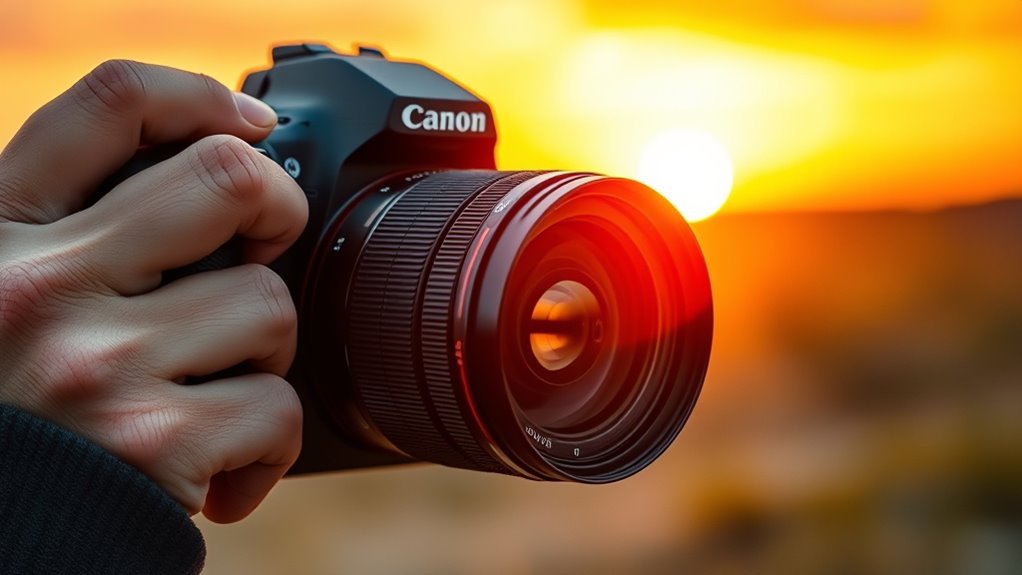
When selecting a premium professional DSLR lens, I consider key factors like image quality, autofocus speed, and aperture flexibility to guarantee I get sharp, well-focused shots. I also pay attention to build quality and compatibility with my camera to maximize durability and performance. Understanding these points helps me choose a lens that matches my specific photography needs perfectly.
Image Quality Standards
Choosing a premium professional DSLR lens hinges on several critical image quality factors that guarantee every shot meets high standards. First, I look for lenses that deliver sharp, detailed images across the entire frame, even when shot wide open at their maximum aperture. Superior optics, like aspherical elements and low-dispersion glass, are essential to minimize chromatic aberrations, distortions, and ghosting, resulting in clearer images. The ability to produce beautiful background blur, or bokeh, depends on aperture blade design and size, often f/1.4 to f/2.8 for premium lenses. Advanced lens coatings help maintain consistent color reproduction and contrast by reducing flare and reflections. Additionally, precision autofocus, minimal focus breathing, and edge-to-edge sharpness ensure the overall image quality meets professional standards.
Autofocus Precision and Speed
Autofocus performance is a key factor in ensuring your images are sharp and in focus, especially with premium professional DSLR lenses. The autofocus precision largely depends on the lens’s motor type; USM and STM motors provide faster, more accurate focusing compared to standard DC motors. Autofocus speed is also influenced by the lens’s focusing algorithm and the camera’s autofocus system, affecting how quickly subjects are locked in. High-end lenses often feature advanced tracking capabilities, making it easier to keep moving subjects in focus, even in tricky lighting. The number of focus points supported by the lens and camera also impacts speed and accuracy. Keep in mind, autofocus can be compromised by low contrast scenes, poor lighting, or calibration issues, so choose a lens with reliable AF performance.
Aperture Versatility
Aperture versatility plays a crucial role in selecting a premium professional DSLR lens, as it directly influences a lens’s ability to adapt to different shooting conditions and creative needs. A wider maximum aperture, like f/1.4 or f/1.8, lets in more light, ideal for low-light situations and achieving a stunning, shallow depth of field. Variable aperture zooms, such as f/4-5.6, offer flexibility across different focal lengths but may reduce brightness at longer zooms, affecting exposure and creative control. Prime lenses with fixed apertures often deliver superior optical quality and consistent exposure, perfect for specialized work. Additionally, manual aperture control allows precise adjustments for artistic effects. Lenses with broad or adjustable apertures support a wide range of photographic styles, from portraits to landscapes.
Build and Material Quality
When evaluating premium professional DSLR lenses, build and material quality are crucial factors that directly impact durability and performance. High-quality lenses use durable materials like metal alloys, aerospace-grade aluminum, or high-strength plastics, ensuring longevity and resistance to wear. The optical elements are crafted from low-dispersion and high-refractive-index glass, which reduces chromatic aberration and sharpens images across the frame. Precise assembly with tight tolerances ensures smooth focus and zoom rings, supporting reliable manual operation even in demanding conditions. Weather sealing with rubber gaskets and protective coatings on the lens barrel shield against dust, moisture, and environmental elements, making them ideal for outdoor shoots. Advanced coatings such as multi-layer anti-reflective or Nano coatings further enhance image quality by minimizing ghosting, flare, and reflections.
Compatibility With Camera
Choosing the right premium professional DSLR lens requires verifying compatibility with your camera system. First, check that the lens mount matches your camera’s mount type, like Canon EF, Nikon F, or Sony E. Next, confirm whether the lens is designed for full-frame or crop sensor (APS-C or DX) cameras; mismatched sensors can affect image quality and framing. Also, make certain the lens supports your camera’s autofocus system, such as USM, SWM, STM, or AF-P, for smooth focusing. Confirm that the lens’s electronic features, like aperture control or image stabilization, are compatible with your camera’s electronics. Finally, review the physical dimensions and weight to match your handling preferences and camera body. Compatibility is key to unlocking your lens’s full potential.
Size and Weight
Size and weight are essential factors to contemplate because they directly impact how comfortable and practical your lens will be during extended shoots. Larger, heavier lenses like telephoto zooms often deliver superior image quality but require extra support, such as tripods or monopods, to stay stable. On the other hand, compact and lightweight lenses, like prime or standard kit lenses, are easier to carry and handle for long periods. The size of a lens usually correlates with its maximum aperture; faster lenses tend to be bulkier due to larger glass elements. Consider how the weight affects your mobility and comfort, especially if you shoot handheld frequently. Heavier lenses can cause strain and influence your overall camera setup, so balance your needs for quality with practicality.
Optical Stabilization Features
Optical stabilization features can considerably enhance the performance of premium DSLR lenses, especially in challenging shooting conditions. They compensate for camera or lens movement, producing sharper images in low light or when handheld. Many high-end lenses include sophisticated systems that can correct for up to four or more stops of camera shake, enabling slower shutter speeds without blur. There are two main types: lens-based stabilization, which moves internal optical elements, and sensor-based systems that adjust the camera’s image sensor. The effectiveness of stabilization varies with focal length, with longer lenses benefiting more from advanced stabilization. When selecting a lens, consider how well its stabilization system integrates with your camera body and how reliably it maintains sharpness during high-magnification or video shooting, ensuring consistent, professional results.
Price and Budget Range
Premium professional DSLR lenses generally fall between $1,000 and over $3,000, reflecting their advanced optical quality and superior build. When budgeting, it’s important to consider additional costs like filters, lens cases, and maintenance accessories, which can add to the overall expense. Entry-level professional lenses often start around $1,000, but high-end models with specialized features can surpass $5,000. The price usually correlates with factors like aperture size, autofocus motor type, and optical stabilization, impacting your total investment. Establishing a clear budget helps you prioritize essential features and ensures your lens choice aligns with both your photographic needs and financial capacity. Being mindful of these factors will help you make a well-informed decision.
Frequently Asked Questions
How Do Lens Coatings Affect Image Quality and Color Accuracy?
Lens coatings markedly improve image quality and color accuracy by reducing reflections and flare. I’ve noticed that coated lenses produce sharper images with richer colors, even in challenging lighting. They also minimize ghosting, ensuring clearer photos. When I use coated lenses, I see less distortion and better contrast, which helps me capture true-to-life images. Overall, coatings are essential for achieving professional results with vibrant, accurate colors and crisp detail.
What Are the Best Lens Options for Low-Light Professional Photography?
If you’re serious about capturing breathtaking shots in near darkness, you need lenses with incredible low-light performance. I swear by fast prime lenses like the Canon 50mm f/1.2 or Nikon 58mm f/1.4—they let in so much light, it’s like turning on a floodlight! These lenses excel at high ISO settings and deliver crisp, detailed images even in dim environments. Trust me, they’ll transform your night photography!
How Does Autofocus Performance Vary Between Different Premium Lenses?
Autofocus performance varies considerably between premium lenses. I’ve found that top-tier lenses, like those from Canon and Nikon, feature fast, accurate autofocus with silent operation, ideal for professional work. Some lenses incorporate advanced motors, such as USM or SWM, enhancing speed and precision. However, performance also depends on your camera body’s autofocus system. Overall, investing in a high-quality lens guarantees reliable, smooth autofocus, essential for capturing sharp images quickly.
Are There Compatibility Issues With Full-Frame and Crop-Sensor Cameras?
Yes, there can be compatibility issues between full-frame and crop-sensor cameras. I’ve found that some lenses are designed specifically for full-frame, so they work perfectly on those bodies but may cause vignetting or reduced image quality on crop sensors. Conversely, some lenses are optimized for crop sensors, which can limit their use on full-frame cameras. Always double-check the lens specifications to verify compatibility with your camera type.
What Maintenance Routines Ensure Long-Term Durability of Premium DSLR Lenses?
Back in the day, cameras didn’t need as much TLC, but now, I always clean my lenses with a soft microfiber cloth and lens cleaner after each shoot. I regularly check for dust and fungus, especially if I travel. I store my lenses in a dry, cool place and use lens caps and filters to protect the glass. Proper maintenance keeps my lenses sharp and long-lasting.
Conclusion
When choosing a premium DSLR lens, remember that about 70% of professional photographers prioritize image quality and autofocus speed. Investing in the right lens can transform your photos, whether you’re capturing portraits or wildlife. With options like a 50mm prime or a powerful telephoto zoom, you’ll find a lens tailored to your style. So, pick wisely and watch your photography skills soar—your perfect shot is just a lens away.
